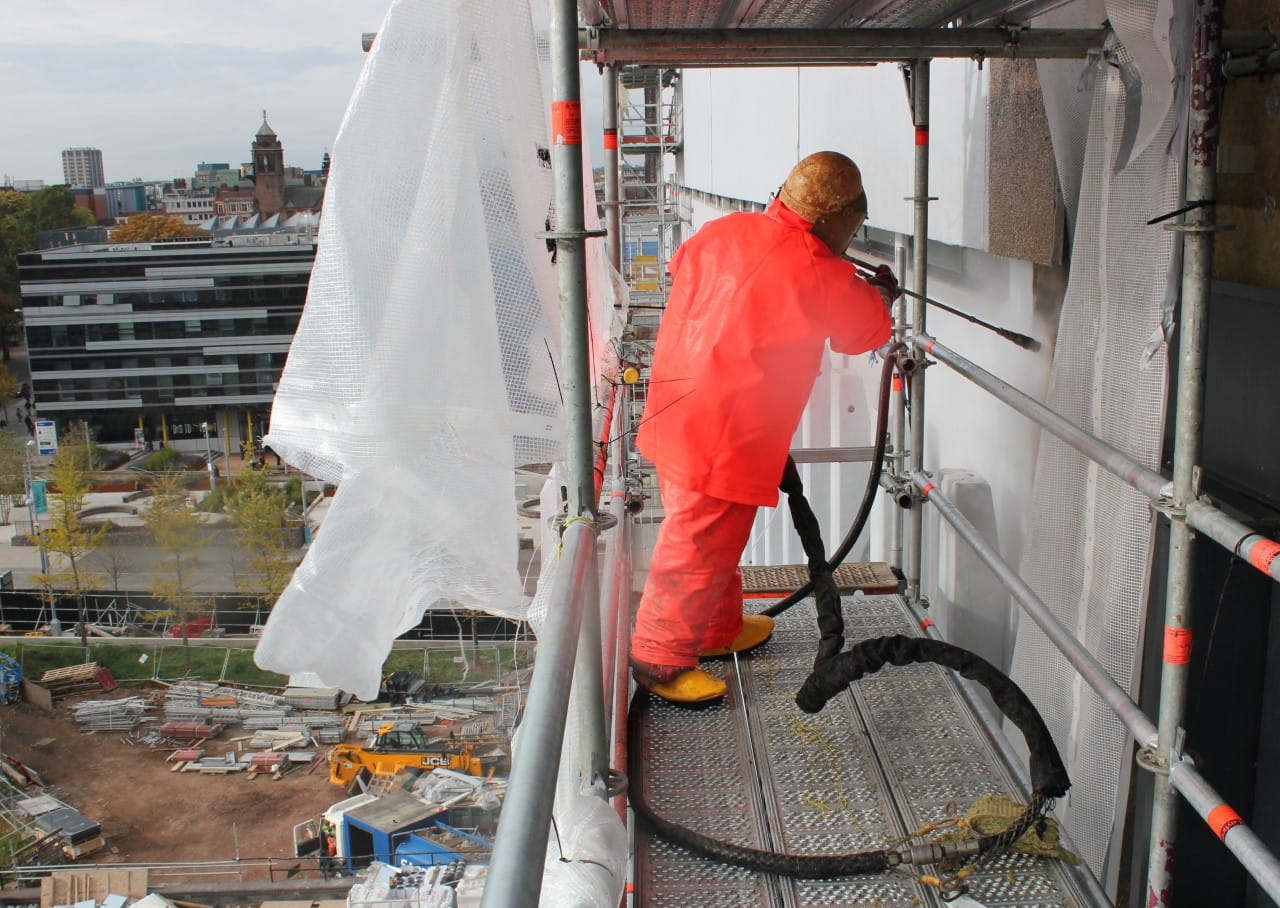Smart jetting reduces pressure on university refurb project

WJA member Sabre Jetting Services has devised a method to remove render from concrete surfaces using reduced water pressures.
The innovation is helping control client costs and ensure project deadlines are met during a major university refurbishment project.
Sabre Jetting has been commissioned by construction and civil engineering specialist McLaughlin & Harvey to support the new-build and refurbishment project for Coventry University.
Its water jetting teams are carrying out surface preparation work on the university’s seven-storey Graham Sutherland Tower, part of the university’s faculty of arts and humanities.
Water jetting rethink
A key priority has been the need to preserve the tower’s large aluminum windows. They are being retained, but could have been damaged by the conventional technique to removing render from concrete.
This led Sabre Jetting Services to rethink its approach. Its Managing Director, David Malin, who is Chairman of the WJA’s Technical Committee, explained how less turned out to be more.
He said: “Surface preparation is usually carried out at pressures of at least 2,500 bar, which is 36,000 psi. But at that pressure, the windows were at greater risk of being damaged.
“This meant a team of operatives would have had to put in extensive protection measures, such as boarding and taping, before our teams could start work.
“Instead, I thought perhaps we could try lowering the water pressure and increasing the flow rate. We did a series of trials and found a suitable technique that worked.”

Reduced client costs
Sabre Jetting found the ideal pressure and flow combination was water pressure at 1,150 bar (17,000 psi) while increasing the water flow rate from 25 to 45 litres per minute.
At those levels, jetting operatives could remove the cementitious render, which included a grit surface coating, without the windows needing substantial protection, using a four-jet rotating nozzle.
David Malin said: “It has turned out to be very effective. Technical know-how, a willingness to try something new, and the skill of our operatives
has contributed to a good solution. The method of removing the render in this manner has substantially reduced costs for the client.
“It’s an example of how we try to think outside the box on behalf of our clients, whether that’s to improve safety, productivity, sustainability, or protect surfaces and control costs, which was the primary factor in this case.”
WJA President John Jones said: “This project is a very good example of the advantages of water jetting, and how WJA members add value in planning and delivering building maintenance and refurbishment work in the most effective and sustainable ways.”
Sabre Jetting has had to overcome other challenges as it has carried out the work over the last nine months. The works required a significant amount of extra-long jetting hoses to be laid around the work area to ensure access around a complex site and to work at height.
Water jetting – best solution
Its teams have been able to remove around 50m2 of render a day working on the historic Graham Sutherland Building, which opened in 1967.
Water jetting has been the ideal technique to prepare the concrete surfaces for the paint finish required by the design plan. Using mechanical tools would have damaged the concrete, risked damaging the windows, and taken longer.
Founded in 1984, Sabre Jetting delivers a wide range of water jetting services, including hydrodemolition, surface preparation, pipe cleaning, tank cleaning, pile cropping and heat exchanger cleaning.
It is the winner of the 2021 Construction News Training Excellence Award after developing a custom-built water jetting training facility and an internal training programme that breaks down learning and language barriers, ensuring inclusion for all employees.
WJA – backing excellence
The WJA champions high standards in operational delivery and safety thought its three codes of practice – the Blue Code for high and ultra-hire pressure water jetting, the Red Code for water jetting in drains and sewers, and its new Purple Code, about to be released, for pressure washing.
The association is also the UK’s largest provider of water jetting training. Its courses, accredited by City & Guilds, give operatives a firm grounding in safe water jetting practice, through a Safety Awareness course.
Operatives also learn hands-on skills through four practical modules: surface preparation, tube and pipe, hydrodemolition, and drain and sewer. The WJA also offers a pressure washing course.
Find out more
If you want to find out more about how water jetting can support your construction, refurbishment and cleaning projects – or about WJA training and membership.
Talk to the WJA today. Telephone: 020 8320 1090. Email: info@waterjetting.org.uk.

